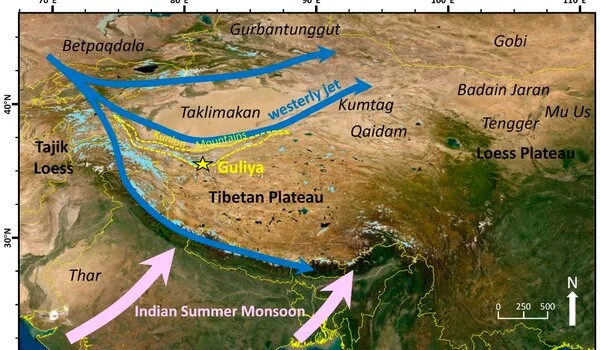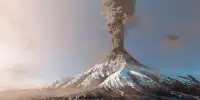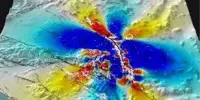Researchers from The Ohio State University are using dust trapped in glacier ice in Tibet to document past changes in Earth’s intricate climate system and, hopefully, one day help predict future changes. Their findings suggest that the dust composition in samples collected from different areas and depths of the same glacier can vary greatly, implying that a complete dust record may hold more secrets than scientists realize.
Strong winds can cause a slew of chain reactions in the atmosphere, affecting everything from human health and marine biochemistry to the balance of carbon dioxide in the atmosphere. The effects of these microparticles on the surrounding atmosphere are largely determined by their size, shape, and chemical composition.
In a new study published in the Journal Geosciences, researchers worked to better understand how dust affects and is affected by climate by examining dust particles trapped inside ancient ice, or what Emilie Beaudon, co-author of the study and a senior research associate at the Byrd Polar and Climate Research Center, refers to as ‘cryo-dust.’
“We can extract information about Earth’s environmental condition at the time the snow was deposited and the ice was formed by looking at dust composition through the ice,” she said. “We might be able to learn whether it was a relatively dry or wet period, or we might be able to infer where the dust originated, and thus obtain information on past atmospheric influences.”
But researchers need a lot of ice to be able to collect that data.
We can extract information about Earth’s environmental condition at the time the snow was deposited and the ice was formed by looking at dust composition through the ice.
Emilie Beaudon
Ice cores, cylinders of ice drilled from glaciers and ice caps, have long been used as comprehensive archives of Earth’s climate system because of how well-preserved they are. As layers of ice accumulate over seasons and years, aerosols accumulate within each new coating, eventually providing researchers with very detailed records of the planet’s tumultuous climate history. With the help of these natural time capsules, scientists can learn about what the world looked like at the time, including aspects like greenhouse gas concentrations, as well as volcanic, solar and biological activity.
The ice used in this study was collected from the Guliya Ice Cap in Northwestern Tibet, which is home to one of the largest atmospheric dust source regions in the Northern Hemisphere, second only to the Sahara Desert. Because the region is influenced by westerly winds, much of the dust picked up there is blown toward major cities in East Asia, according to Beaudon. For example, in 2021, China experienced its largest dust storm in a decade, forcing entire cities to seek shelter, raising concerns from the scientific community about the effects of climate change on the frequency and intensity of such events.
But scientists don’t have enough data to help identify how Central Asian desert dust is transported over long distances, nor how it changes over time. Studying a dust record from a Tibetan ice core is one of the only ways to provide a long-term perspective on the Central Asian dust cycle, Beaudon said.

In 2015, a team of researchers from the United States and China helped drill for ice cores from different locations at the Guliya ice cap, before shipping these cores back to the lab at Ohio State. Beaudon’s team analyzed two of the ice cores, investigating the area’s dust record by studying microparticles collected on filters from melted ice, as well as those trapped in typical ice subsamples. Beaudon noticed that the encased dust wasn’t uniform; instead, each deposit was an unlikely array of different colors, sizes and layers.
“That’s how the idea of trying to figure out where the dust was coming from arose because there were already so many visual cues highlighting their differences,” Beaudon explained. Beaudon’s team also attempted to determine whether the majority of the particles in the ice originated in the Taklimakan desert near the Guliya ice cap, or if they were transported there from other distant locations.
“With these preliminary samples, we wanted to demonstrate that there is actual variability in their geochemistry and mineralogy,” she explained. “We discovered that not all dust from the same desert is the same, and even within the same glacier, you don’t always have the same material.”
Overall, the study notes that the particularly old Guliya glacial dust archive is a prime candidate for deeper exploration, implying that Beaudon’s work opens up many research avenues by using additional ice core samples to develop higher-resolution dust records, including studying the microbial populations that exist inside the ice and feed on the nutrients cryo-dust carries within it.
Beaudon eventually wants her work to contribute to the study of glacial records on planets other than Earth. “My goal is to become very knowledgeable about cryo-dust,” she explained. “I hope to study any ice cores or samples taken from Mars or any other planet that are ever drilled.”
















